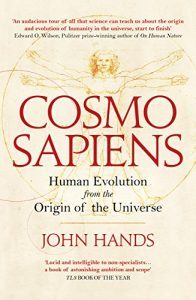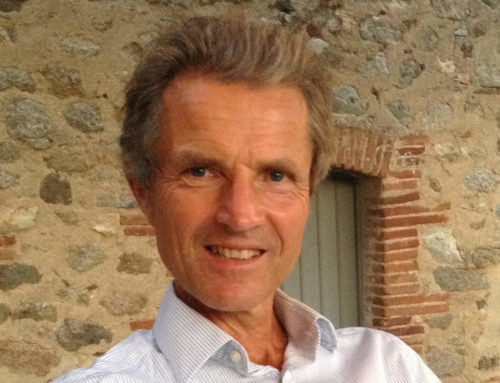Book review by David Lorimer
COSMOSAPIENS
John Hands
Duckworth, 2015, 704 pp.
ISBN: 978-0-715-649558
10 years in the making, this tour de force is a critical examination of scientific theories and evidence – systematic observation or experiment – about the origin and evolution of matter, life, consciousness and humankind. As such, it could scarcely be more ambitious, but the result is a triumph of detailed conceptual analysis covering the fields of fundamental cosmology, physics, biology and the evolution of philosophical and religious ideas. The author states his viewpoint at the beginning of the book by saying that he was born and educated a Catholic, became an atheist and is now an agnostic with no prior beliefs in theism, deism or materialism; he maintains an impartial stance even if he is accused of not doing so. In the course of his research, he consulted and received detailed feedback from over 60 experts. His writing is clear, careful, painstaking and critical. Throughout the book, he gives his own definitions of key terms as and when they come up in the narrative, and there is also a glossary of terms at the end.
The four parts examine scientific explanations for the emergence and evolution of matter and energy, then emergence and evolution of life, the emergence and evolution of humans, and finally some systematic conclusions, as well as observations about the limitations of science. It becomes clear in the course of discussing various fields that there are patterns of thought that have ossified into preconceptions that are taken for granted and rarely questioned by those inside the field. Beginning with a survey of origin myths, the author moves on to the cosmology of the Big Bang before setting out what this orthodox theory fails to explain, which is then elaborated in the following chapter. He discusses a variety of other cosmological conjectures before considering more generally the problems facing cosmology as an explanatory means in terms of practical difficulties, data interpretation, inadequate theory and intrinsic limitations of science. He then explores the reasonableness of cosmological conjectures and tests to which they can be subjected as well as approaches involving fine tuning and multiverses. Moving on, he looks at the evolution of matter on a large scale, then on a small-scale, and overall patterns that apply. In his detailed conclusions to this section – set out in 23 numbered paragraphs – he observes that some people conflate mathematical with scientific proof and, on the basis of his analysis, does not think that the standard Big Bang model meets science’s test for a robust theory. Indeed, the whole question of origins may in fact be beyond science to ascertain with any certainty due to the fact that the central claims are untestable.
Part Two addresses the emergence and evolution of life with the same thoroughgoing analysis of theories and evidence. In considering the history of biology and the development of science’s explanation of life, he discusses vitalism and orthodox reactions to it, including more modern formulations involving David Bohm and Rupert Sheldrake. The author proceeds to lay out the claimed characteristics of life, arriving at a definition that rejects the reductionist argument that there is no distinction between what is alive and what is not alive; for him, the difference is qualitative and analogous to a phase change. The following chapters explore the emergence of life in terms of evidence and hypotheses, as well as the development of scientific ideas about biological evolution, then the evidence for these ideas in terms of fossils, analyses of living species, the behaviour of the species and the human lineage. The author summarises current orthodox thinking about causes of biological evolution, while setting out specific elements that it cannot explain before exploring nearly twenty complementary and competing hypotheses with respect to complexification, collaboration and the evolution of consciousness. In the course of this part, he brings in the thinking of Prince Kropotkin on cooperation and mutual aid, which forms an important element in his overall conclusions.
The impossibility of divorcing ideas from beliefs, whether in God or in materialism, comes up again in this section, exacerbated by the fact that evidence is scarce and open to different interpretations. In his conclusions to this biological section, he reflects on reactions by specialists to drafts that he sent, which he groups into five types: peremptorily dismissive, politely dismissive, ‘you don’t know the facts’, ‘you appear to know the facts but you don’t understand them’, ‘Neo-Darwinism is compatible with all the evidence and all the different hypotheses.’ It is very clear that the author does know the facts, but he also considers their overall context and embedded assumptions, which those in the field frequently fail to do. This makes for uncomfortable reading and goes a long way to explaining the reactions above. Again, his conclusions are set out in 53 numbered paragraphs, some with subsections, from which he draws four qualitative laws of biological evolution: ‘competition and rapid environmental change cause the extinction of species; collaboration causes the evolution of species; living things evolved by progressive complexification and centration along fusing and diverging lineages that lead to stasis in all but one lineage; a rise in consciousness correlates with increasing collaboration, complexification and centration.
Part Three deals with the emergence and evolution of humans with a special emphasis on the development of reflective consciousness. The author considers various models and explanatory hypotheses before looking in more detail and the evolution of human thinking from primeval to philosophical to scientific. He observes that Indian sages emphasise the underlying unity of reality, and he makes an important distinction, illustrated in a chart (p. 505), between the development of insight and reasoning, corresponding broadly to the right and left hemispheres of Iain McGilchrist’s model, incidentally not mentioned here. Under insight we have psychological, ethical, mystical, mathematical, scientific and artistic, while under reasoning there is natural philosophy, metaphysics, logic, epistemology, ethics and aesthetics. Ethical thinking goes beyond competition and instinct by insisting that we can only achieve by acting unselfishly: ‘at root it is a prescription for cooperation not competition in order to achieve progress for humanity.’
The chapter on scientific thinking describes the scientific method and the emergence of the three branches of physical, life and medical sciences (see chart on p. 516), then of psychology in the late 19th century. The rise of scientific specialism is accompanied by a corresponding reductionist methodology, but more recently we see the emergence of a convergent trend, especially in physics with its quest for a theory of everything (of course, this should include consciousness….). The conclusions to the section are set out in 35 paragraphs and make the central point, as for the emergence of life, that reflective consciousness is a change of kind, not merely of degree. The author then brings together the strands of his thinking – which has parallels with that of Elisabet Sahtouris (not mentioned) – that convergence and complexification also correspond to increased cooperation and collaboration, as Kropotkin pointed out over 100 years ago. Globalisation and communications, as well as the establishment of global institutions, have exhibited this trend, particularly since the end of the Second World War. It represents, despite the current prominence given to terrorist attacks, a gradual overcoming of competition, aggression, hierarchism and divergence by cooperation, altruism, complexity and convergence, as thinkers like Teilhard de Chardin envisioned some 80 years ago.
The final part on a cosmic process discusses the limitations within the domain of science in terms of observation and measurement, data, subjectivity, method, theory and defective science; then limitations of the domain of science based on subjective experiences, social concepts and values, untestable ideas and metaphysical questions. Scientific theories are necessarily underpinned by philosophical assumptions, which in turn influence the selection and interpretation of data. As William James and Prince de Broglie also observed, such assumptions should be reviewed, modified or abandoned in the light of conflicting evidence. In particular, the reductionist approach is limited in its explanatory power for complex, open, interactive and emergent systems (p. 566). For orthodox readers, the author’s proposal that we need to postulate a new form of energy – psychic energy associated with mind – will be a step too far, but there is good evidence for such effects that are frequently discussed in this Review. The author questions and indeed demonstrates the limitations of current scientific thinking, but also highlights the limitation of the human mind, which can be inferred from reports of mystical experience where subjects are immersed in rather than separated from reality. The author’s final conclusions are set out in a further 39 paragraphs, at the end of which he arrives at his short answer to question of what and who we are: ‘the unfinished product of an accelerating cosmic evolutionary process characterised by collaboration, complexity and convergence, and the self reflective agents of our future evolution.’ At the end of this dense and closely argued treatise, one can only agree with Tim Crane, Knightsbridge professor of philosophy at Cambridge, that ‘this is a truly exceptional piece of work.’
Buy Cosmosapiens here.

